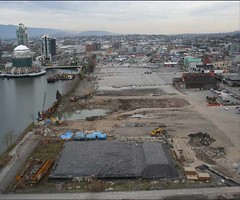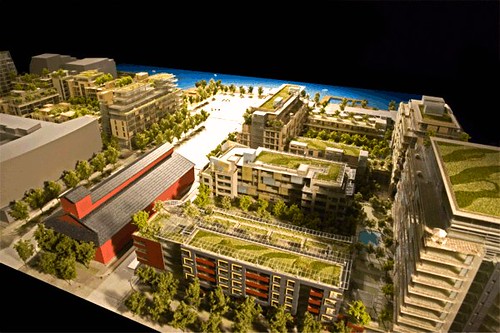How Brownfield Redevelopment Reduces Pollution
The federal Environmental Protection Agency has released a comprehensive research report demonstrating that redevelopment of contaminated industrial sites in inner cities brings substantial environmental benefits. The agency studied 163 brownfield sites in five cities, comparing their impacts with those of sites where development was likely to go had the brownfields not been available.
For over 90 percent of the sites, the brownfield locations were found to have superior environmental performance compared to the alternative locations. In particular, brownfield redevelopment was found to produce 32-57 percent less carbon dioxide and other air pollutant emissions per capita relative to conventional development. Stormwater runoff for the redevelopment sites was determined to range 43-60 percent less than the conventional greenfield alternatives. All of the sites had been cleaned up with EPA assistance and replaced with residential and commercial development that was completed or in progress at the time of the study.
The five cities included the following:
- Seattle, WA
- Baltimore, MD
- Minneapolis-St. Paul, MN
- Emeryville, CA
- Dallas-Fort Worth, TX
Most of the redevelopment sites were in inner-city areas conducive to compact development. Most of the alternative locations, chosen based on prevailing development trends in each region, were in suburban or exurban greenfield areas, 
The performance of both sets of locations were measured and compared for metrics such as vehicle use per capita, air pollutant emissions per capita, personal vehicle energy use per capita, and stormwater runoff and pollutant loads. These were developed with data from regional transportation demand models, a watershed management model, and INDEX, a geographical information system (GIS)-based analytical tool. (NRDC has also used INDEX, which was developed by our friends at Criterion Planners, for a number of research products.) The results show that urban brownfield redevelopment not only produces economic benefits and the environmental benefits of cleanup of contamination; it also yields the environmental benefits that come with smart growth.
The study found that brownfield redevelopments also produce substantially lower loads of all pollutants studied, according to the study, ranging from 9-80 percent for conventional pollutants and 59-72 percent for metals. (These estimates do not include the potential reduction in pollutant loads from cleanup of the brownfield properties, nor some of the pollution from contaminated properties that would remain undeveloped if the redevelopment had occurred on the greenfields instead.)
The authors note that the results are consistent with what might be expected from other published literature. They also report that the results varied somewhat among the locations studied:
"For example, because Seattle is surrounded by many bodies of water and mountains, some of the outlying areas are accessible to the central city or other destinations only by bridge, ferry, or circuitous routes. This may explain why the results for the Puget Sound area indicate considerably greater reductions in vehicle miles traveled and emissions under the brownfields redevelopment scenario than for the other cities.
"The estimated percentage reductions in stormwater runoff and pollutant loads are dependent on precipitation, soil type, and land use type, which vary within each region as well as across regions.
Generally, the percentage runoff reduction is greatest when the alternative greenfield site is on forest land, lower for pasture, and even lower for agricultural land."
Many of our very best examples of walkable, smart, green development have been built on former brownfield sites, including Millennium Water (the former Vancouver Olympic Village), the highest-scoring project evaluated under LEED for Neighborhood Development. (See image at top of post; the first inset shows the site before redevelopment.) Residents of Atlantic Station in Atlanta (cafe, just above), built on the site of a former steel plant, have been found to drive only about a fourth as much as do residents of Atlanta as a whole.
This study is the result of a long-term collaboration between the EPA Office of Brownfields and Land Revitalization and the EPA Office of Sustainable Communities. The agency's Office of Water and National Center for Environmental Economics also reviewed the research methodology. For the summary, go here; the full report may be downloaded here.
First published on TheAtlanticCities.com. Move your cursor over the images for credit information.


